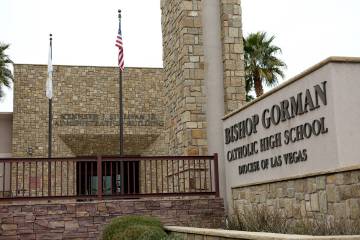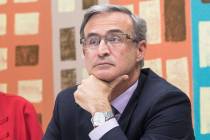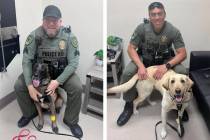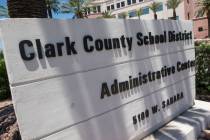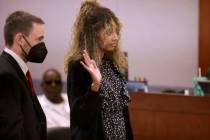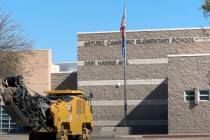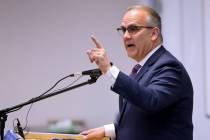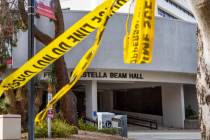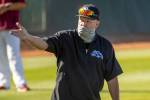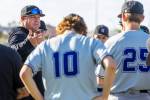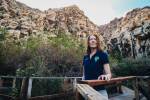Atkinson back to driving UNLV’s med school since health scare
A major health scare forced Barbara Atkinson away from her duties for about four months last year, leaving a medical school three weeks shy of its opening date hanging in the balance.
“I just have to say, I was sick enough that I wasn’t sure I was able to come back,” Atkinson, the founding dean of UNLV’s medical school, said in an interview this month. “But I had such incredible care at (University Medical Center), and the rehab center afterward, that I came back with full everything, it was incredible.”
She returned Nov. 1, and aside from an additional surgery over the Christmas break, she’s back to working on major milestones to continue to move the fledgling school forward. This was her first interview since returning to her duties.
“It’s been exciting,” she said. “There was a lot I had felt like I left undone.”
The university did not disclose the nature of her departure last summer other than saying she was hospitalized due to a “very serious” illness.
UNLV President Len Jessup said two major milestones — the transition of the clinical enterprise from the University of Nevada, Reno to UNLV, and the launch of the first class on the academic side — happened while Atkinson was on leave.
“There were some pretty big tasks during that time, and I thought it went well,” Jessup said. “She’s built a great team.”
Dr. Michael Gardner, vice dean of clinical affairs, was not employed with the school when Atkinson went on on medical leave, but said her leadership paved the way for the school to successfully begin classes during her absence.
“A great leader sets up an organization that runs well without her hands-on presence,” Gardner, who joined the school on Nov. 15, said. “She picked a lot of great people before me, and whether she’s here on a day or not here on a day, we do our job.”
Student Lauren Hollifield said the inaugural class saw little change when Dr. Shawn Gerstenberger stepped into the role of acting dean.
“The school was good about keeping us updated on her condition,” Hollifield, 25, said. “From the administrative standpoint, everything ran pretty smoothly.”
And since returning, Atkinson has been involved in all major decisions, and has been available on any issues “large or small” requiring her input, Gardner said.
Fundraising work
Fundraising and continuing to move the needle on the accreditation process have been Atkinson’s top priorities. She said she’s confident the school can bring in $250 million in funding for a new medical education building.
“That’s been one of the main things I’ve been working on,” she said. “Finding where the right donors are and moving that whole project ahead — it takes a lot of time.”
Jessup said fundraising efforts continued successfully in Atkinson’s absence. During that time she assisted in finding donors by phone, Jessup said.
And fundraising activities have continued on an upward trajectory since her return, he said, with several top prospects likely to make significant contributions to the school’s new medical education building.
“That project continued on very well while she was sick and it continues on today,” Jessup said. “We’re in good shape where we are.”
The university’s executive director of planning and construction, David Frommer, has said the university would like to begin construction in 2021. Atkinson believes it could be sooner.
“I’m hopeful it’s not any longer than that,” Atkinson said. “But I tend to be on the hopeful side, and he tends to be on the sensible side.”
Successful fundraising activities are also key, she said, to start research programs and she’s been working on securing other donors to increase the scholarships available for the second class.
A fundraising drive in 2015 secured full scholarships for all 60 members of the charter class, and 25 each for the remaining three classes.
“Right now I think we have a little more than that — one or two more,” she said. “It’s a watch and see situation.”
The scholarships will be doled out on the basis of need, she said.
Quest for accreditation
Atkinson hopes the next accreditation visit from the Liaison Committee on Medical Education, slated for March 2019, will go smoothly as well. School officials are working on the self-study, which must be submitted to the LCME in November.
“We need to show we have the curriculum for the third and fourth year ready, that our finances are in place and that we have all the faculty hired that we would need for those students,” Atkinson said.
After the March 2019 visit, the LCME should decide within two months, Atkinson said, on whether the charter class can move onto its third and fourth years of schooling.
“We’re not expecting a problem with the accreditation, but we want to do it right because there’s always a chance that something won’t go right,” she said.
She said the school will continue to bring in key faculty over the next 10 years. Atkinson is close to finalizing a new chair for internal medicine, who will recruit 20 to 30 new positions over the next five to 10 years. Another key position that is in the process of being filled is that of chief financial officer.
‘Even better’
By the time the accreditation visit occurs, 120 students will be in the midst of their medical education, as the second class will begin this summer.
Atkinson said the school received 1,100 applications — about 200 more than last year — for 60 open spots. More than 300 of the applications were from students who are either from Nevada, or those with close ties to the state.
As the second class shapes up, the average Medical College Admission Test score is 510, compared with the national average of 500, and impressive GPAs — 3.74 for pre-med coursework.
Atkinson said the school is continuing its strategy of building the class with homegrown talent, even as some have raised concerns about it. At the December Board of Regents meeting, Regent Trevor Hayes said he worried this strategy would turn the medical school into a “parochial” institution.
Atkinson disagrees.
“We have one of the most forward-thinking curriculums in the country,” she said. “The feature for us is the kind of doctor we train — forward-thinking doctors who will be practicing medicine in the future. It’s more important to us than looking at a national pool.”
Additionally, Atkinson said the school is supported by the state.
“I don’t see the need to put $45,000 into a non-Nevada student when we have excellent students in Nevada,” she said. “The whole goal of the medical school in the first place was to educate students from Nevada who would stay in Nevada to practice. They’re more apt to stay if they come from Nevada.”
Of the students who received offer letters so far, 20 applicants have been accepted to multiple schools.
“The first class is dear to my heart because they wanted to be a part of our first class and guide us through our accreditation,” she said. “But if you looked at this (second) class on paper, they’re even better than our first.”
Contact Natalie Bruzda at nbruzda@reviewjournal.com or 702-477-3897. Follow @NatalieBruzda on Twitter.






